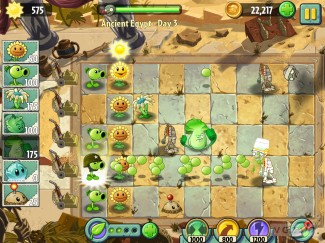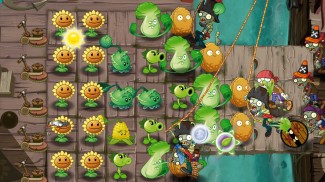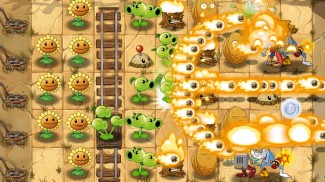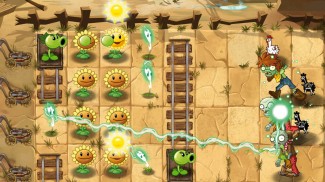Bastion
LQ: 9.15
Recommended Age: 10+
Skills Used: Planning, Working Memory, Mathematics, Reading

Plants vs. Zombies 2 is an action strategy game where players must prevent enemy zombies from crossing their front lawn and entering the house. Players strategically place plants throughout the yard in an effort to stop the forward progress of the zombies. There’s a good mixture of both offensive and defensive plant units. Pea shooters eventually wear down zombies, while walnuts stop them in their tracks. Depending on the strength and number of zombies (which varies), players must use the combination of plants that will both protect the house and keep the zombies at bay. But players do not have an unlimited supply of plants. They must use sunflowers to gather sunlight and create energy for more plants. Only these energy units are released in intervals, and player often must wait — sometimes until the last minute — to grow a plant that has the best chance of taking down a zombie. It’s an extremely easy game to pickup (a helpful tutorial guides players through their first few games) but becomes difficult to master. Plants vs. Zombies 2 features mild cartoon violence and is recommended for children ages 10 and up.
Teachers: check out the classroom guide!
Being efficient and aware of our use of time and effort.
 It's only a matter of time before a zombie will cross the map into the players' line of defense. Players are not "timed" during play, but have little room for procrastination as zombies continue to crowd the map. However, there are ways to buy more time. For example, players can block the grid with walnuts (which are eventually eaten) or freeze enemies for a short while with an ice attack. Stopping and slowing the enemy allows players to accumulate more energy units so they can eventually add more plants to their defenses take out the encroaching zombies. Players must work quickly and efficiently if they wish to beat each level. Once a plant is placed on the ground, players must wait before they can plant another of the same type. This limitation makes multi-tasking crucial, as players must manage time to maximize the production of their plants.
It's only a matter of time before a zombie will cross the map into the players' line of defense. Players are not "timed" during play, but have little room for procrastination as zombies continue to crowd the map. However, there are ways to buy more time. For example, players can block the grid with walnuts (which are eventually eaten) or freeze enemies for a short while with an ice attack. Stopping and slowing the enemy allows players to accumulate more energy units so they can eventually add more plants to their defenses take out the encroaching zombies. Players must work quickly and efficiently if they wish to beat each level. Once a plant is placed on the ground, players must wait before they can plant another of the same type. This limitation makes multi-tasking crucial, as players must manage time to maximize the production of their plants.
Adapting and adjusting to changing conditions and expectations.
 Everything seems like it's subject to change in Plants vs. Zombies 2. There are a variety of zombies each with different strengths and weaknesses. It's up to players to adapt their style of play in to the type of zombies that are invading. For example, regular zombies can be taken care of with a single pea shooter. But Zombies wearing hats are 2 to 3 times as strong, and will require a stronger type of offensive plant to be eliminated. Some zombies enter the map on a tornado and can bypass plants. When this happens players must work to create a defensive unit to slow the zombie, while attacking it with stronger offensive plants. There will be instances where a row of plants are not effective against a wave of zombies. Players can then dig up the plant they put there originally and replace it with something that will yield better results.
Everything seems like it's subject to change in Plants vs. Zombies 2. There are a variety of zombies each with different strengths and weaknesses. It's up to players to adapt their style of play in to the type of zombies that are invading. For example, regular zombies can be taken care of with a single pea shooter. But Zombies wearing hats are 2 to 3 times as strong, and will require a stronger type of offensive plant to be eliminated. Some zombies enter the map on a tornado and can bypass plants. When this happens players must work to create a defensive unit to slow the zombie, while attacking it with stronger offensive plants. There will be instances where a row of plants are not effective against a wave of zombies. Players can then dig up the plant they put there originally and replace it with something that will yield better results.
Developing a systematic approach for setting and achieving goals.
Just after players choose their map, they are shown the locations of the first wave a zombies. Because at this time, players have limited resources, it's important to know which directions the enemy will come from so they can properly align their first few plants. Prior to the start of a level, players must choose which plants they would like to have in their arsenal, because they cannot carry every unit the unlocked. Players should makes sure to carry a good mixture of offensive, defensive, and sunflower plants for a balanced attack.
Use this Play Together guide to learn how you can help your child turn Plants vs. Zombies 2 play time into a positive learning and relationship-building experience. To learn more about why playing games with your children is so important, check out our Science of Play page.
Take a minute to talk with your child about how the Time Management, Flexibility and Planning thinking skills work, and why they are important for success in school and at home.
 Plants vs. Zombies 2 is a single player game, but offers an experience that's an easy one to share with your child. Try taking turns between levels as you play, sharing ideas as you work together to complete the gameplay goals listed below.
Plants vs. Zombies 2 is a single player game, but offers an experience that's an easy one to share with your child. Try taking turns between levels as you play, sharing ideas as you work together to complete the gameplay goals listed below.
Gameplay Goals:
Our Make it Work activities are designed to transform your child’s gameplay to real-world improvements in thinking and academic skills. If you’re just getting started with LearningWorks for Kids, we suggest you try them all to find which are the best for you and your child.
Read over the pages for Time Management, Planning and Flexibility. Then take some time to introduce these skills to your child. Explain to your child that:
Time Management is the thinking skill that helps us complete tasks on time, finish things more quickly and be efficient and aware of our use of time and effort.
Planning is the thinking skill that helps us to develop a systematic approach for setting and achieving goals, and complete tasks by doing things step-by-step.
 Gimme a break. If your child has stagnated while performing a task, such as schoolwork or a chore, get him to move quickly doing something else. This could be a physical activity such as going for a quick bike ride, or something as simple as singing a song at a quickened pace. Getting him to move quickly in a fun (or even funny) activity may help him to become more aware of his pace in relation to other activities. Another strategy would be to take a 5-10 minute exercise break, which could include anything from doing a set of push-ups or sit-ups, running up and down the stairs, or taking the dog out for a short walk. Initially, a parent will want to be in charge of when such breaks occur, but eventually we want the child to learn to identify when he needs to take a break himself, and furthermore, to be able to demonstrate that he is using the break responsibly by coming back to work better than before.
Gimme a break. If your child has stagnated while performing a task, such as schoolwork or a chore, get him to move quickly doing something else. This could be a physical activity such as going for a quick bike ride, or something as simple as singing a song at a quickened pace. Getting him to move quickly in a fun (or even funny) activity may help him to become more aware of his pace in relation to other activities. Another strategy would be to take a 5-10 minute exercise break, which could include anything from doing a set of push-ups or sit-ups, running up and down the stairs, or taking the dog out for a short walk. Initially, a parent will want to be in charge of when such breaks occur, but eventually we want the child to learn to identify when he needs to take a break himself, and furthermore, to be able to demonstrate that he is using the break responsibly by coming back to work better than before.
Create a master calendar of events to plan ahead. Model and use calendars to keep track of family events, and to prepare for all of the important events and deadlines that your child must attend to. Have him personalize individual events using pictures, graphics, stickers, or doodles. Your child may wish to take pictures to put on the calendar as reminders. Place the calendar in a public area, possibly with a duplicate calendar in his room. Encourage him to think about connecting each activity to how he decorated the particular date, helping him understand the details related to each marked date. Have your child post the calendar prominently in his room and give rewards or privileges for keeping it accurate and up-to-date.
Make up a new game. Invent new games by slightly changing the rules, or by taking rules from one game and adding them to another. For example, play a memory game in which players must match opposite images, rather than ones that are alike. Play a basketball “shooting” game in which players get 2, 3, 4, or 5 points depending on the type of shot that is taken. You can even create some absurd challenges, like play horseshoes with a soccer ball, or trying to play baseball using a kickball and no gloves. You can even add a timed element to one of your child’s favorite games, changing the strategy needed to win. After playing, make sure to discuss with your child how he needed to apply different strategies as the rules changed.
All membership plans come with full access to our entire suite of tools learning guides, and resources. Here are a few of the ones we think you’ll like the most: